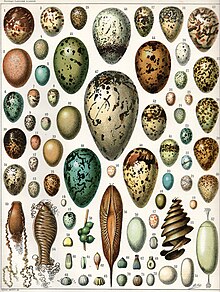


Oviparous animals are animals that reproduce by depositing fertilized zygotes outside the body (known as layingorspawning) in metabolically independent incubation organs known as eggs, which nurture the embryo into moving offsprings known as hatchlings with little or no embryonic development within the mother. This is the reproductive method used by most animal species, as opposed to viviparous animals that develop the embryos internally and metabolically dependent on the maternal circulation, until the mother gives birth to live juveniles.
Ovoviviparity is a special form of oviparity where the eggs are retained inside the mother (but still metabolically independent), and are carried internally until they hatch and eventually emerge outside as well-developed juveniles similar to viviparous animals.
The traditional modes of reproduction include oviparity, taken to be the ancestral condition, traditionally where either unfertilised oocytes or fertilised eggs are spawned, and viviparity traditionally including any mechanism where young are born live, or where the development of the young is supported by either parent in or on any part of their body.[1]
However, the biologist Thierry Lodé recently divided the traditional category of oviparous reproduction into two modes that are distinguished on the basis of the relationship between the zygote (fertilised egg) and the parents:[1][2]
In all but special cases of both ovuliparity and oviparity, the overwhelming source of nourishment for the embryo is the nutrients stored in the yolk, pre-deposited in the egg by the reproductive system of the mother (the vitellogenesis). Offspring that depend on yolk in this manner are said to be lecithotrophic, which literally means "feeding on yolk"; as opposed to matrotrophy, where the maternal circulation provides for the nutritional needs. Distinguishing between the definitions of oviparity and ovuliparity necessarily reduces the number of species whose modes of reproduction are classified as oviparous, as they no longer include the ovuliparous species such as most fish, most frogs and many invertebrates. Such classifications are largely for convenience and as such can be important in practice, but speaking loosely in contexts in which the distinction is not relevant, it is common to lump both categories together as just "oviparous".
|
| |
|---|---|
| Menstrual cycle |
|
| Gametogenesis |
|
| Human sexual activity |
|
| Development of the reproductive system |
|
| Egg |
|
| Reproductive endocrinology and infertility |
|
| Breast |
|
| Human reproductive system |
|
| Diseases and disorders |
|
|
| ||
|---|---|---|
| Modes |
| |
| Fertilization |
| |
| Parental care |
| |
| Related topics |
| |
|
| |
|---|---|
| Types |
|
| Fossil record |
|
| Biology |
|
| Components |
|
| As food |
|
| In culture |
|
| |